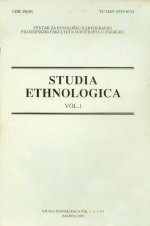Prilozi u grob
Grave - goods
Author(s): Branko ĐakovićContributor(s): Snježana Veselica (Translator)
Subject(s): Customs / Folklore, Cultural Anthropology / Ethnology
Published by: Sveučilište u Zagrebu, Filozofski fakultet
Keywords: ethnology; customs; traditional culture; care about the dead; grave - goods; burial;
Summary/Abstract: Introducing the general cultural context of the custom of burying beside the bodies of the deceased, various objects, the author explains the need to approach this feature of a very complex structure by ethnological research as well. He sums up the results reached by other researchers, who have sporadically, but never systematically, written about these problems, R. Kajmaković, S. Bajić, J Belošević, E. Pašalić, V. Novak and S.A. Tokarjev have given certain classifications of grave-goods according to criteria which, as they considered, make possible further analytical exploration. Taking into account the criteria of "to whom a gift is given", "what is given", "who gives it" and "why it is given", the author has classified posthumous gifts into the following groups: A) - Gifts to older men and women- Gifts to the young - Gifts to children - Gifts to persons having special social status: (seniors, pregnant women, widows, suicides, etc...) B) – Money - Food and drink - Personal objects - Religious objects - Quantities of earth from farms - Objects which were in touch with the deceased C) - Gifts given by the family of the deceased - Gifts given by others to the deceased D) - Gifts given on behalf of a third family member, if someone has already died in the same year - Gifts given out of fear of the deceased in order that he shouldn't come back or become a vampire, or to pay him for something - Gifts for his life on the other world. Analyzing, according to the above-established criteria, the custom of putting gifts into a grave, the author has found that the limits between the groups arc not fixed. Then the author brings forth a more systematic comparative analysis of this custom and concludes that we could to a whole range of new solutions if posthumous gifts were considered as symbols and messages belonging to the posthumous cycle and thus reflecting in themselves a whole range of ancient customs of diverse origins which arc extremely complex in structure and meaning.
Journal: Studia ethnologica Croatica
- Issue Year: 1989
- Issue No: 1
- Page Range: 135-163
- Page Count: 29
- Language: Croatian

